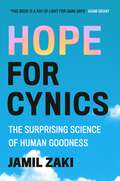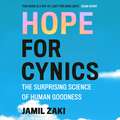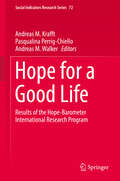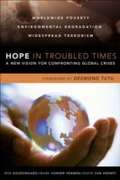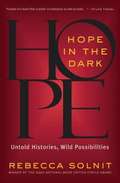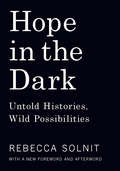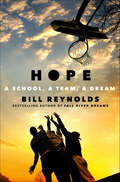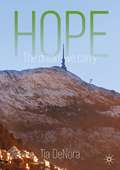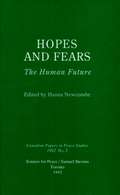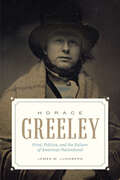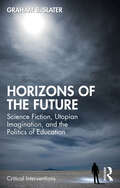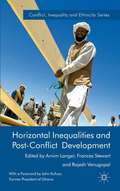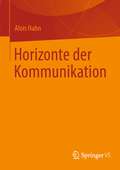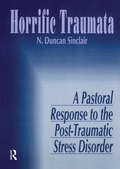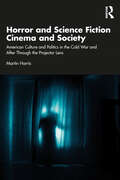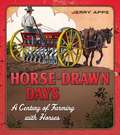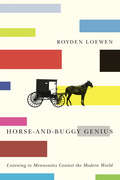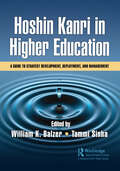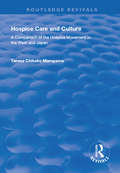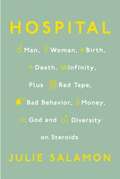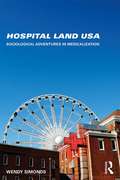- Table View
- List View
Hope for Cynics: The Surprising Science Of Human Goodness
by Jamil ZakiCynicism is making us sick; Stanford psychologist Dr Jamil Zaki has the cure - a 'ray of light for dark days' (Adam Grant, #1 New York Times bestselling author).For thousands of years, people have argued about whether humanity is selfish or generous, cruel or kind. But recently, our answers have changed. In 1972, half of Americans agreed that most people can be trusted; by 2018, that figure had fallen to 30%. Different generations, genders, religions and political parties can't seem to agree on anything, except that they all think human virtue is evaporating. Cynicism is a perfectly understandable response to a world full of injustice and inequality. But in many cases, cynicism is misplaced. Dozens of studies find that people fail to realise how kind, generous and open-minded others really are. And cynical thinking worsens social problems, because our beliefs don't just interpret the world; they change it. When we expect people to be awful, we coax awfulness out of them. Cynicism is a disease, with a history, symptoms and a cure. Through science and storytelling, Jamil Zaki imparts the secret for beating back cynicism: hopeful scepticism. This approach doesn't mean putting our faith in every politician or influencer. It means thinking critically about people and our problems, while simultaneously acknowledging and encouraging our strengths. Far from being naïve, hopeful scepticism is a more precise way of understanding others, and paying closer attention re-balances how you think about human nature. As more of us do this, we can take steps towards building the world we truly want.
Hope for Cynics: The Surprising Science Of Human Goodness
by Jamil ZakiCynicism is making us sick; Stanford psychologist Dr Jamil Zaki has the cure - a 'ray of light for dark days' (Adam Grant, #1 New York Times bestselling author).For thousands of years, people have argued about whether humanity is selfish or generous, cruel or kind. But recently, our answers have changed. In 1972, half of Americans agreed that most people can be trusted; by 2018, that figure had fallen to 30%. Different generations, genders, religions and political parties can't seem to agree on anything, except that they all think human virtue is evaporating. Cynicism is a perfectly understandable response to a world full of injustice and inequality. But in many cases, cynicism is misplaced. Dozens of studies find that people fail to realise how kind, generous and open-minded others really are. And cynical thinking worsens social problems, because our beliefs don't just interpret the world; they change it. When we expect people to be awful, we coax awfulness out of them. Cynicism is a disease, with a history, symptoms and a cure. Through science and storytelling, Jamil Zaki imparts the secret for beating back cynicism: hopeful scepticism. This approach doesn't mean putting our faith in every politician or influencer. It means thinking critically about people and our problems, while simultaneously acknowledging and encouraging our strengths. Far from being naïve, hopeful scepticism is a more precise way of understanding others, and paying closer attention re-balances how you think about human nature. As more of us do this, we can take steps towards building the world we truly want.
Hope for a Good Life: Results Of The Hope-barometer International Research Program (Social Indicators Research Series #72)
by Andreas M. Krafft Andreas M. Walker Pasqualina Perrig-ChielloThis volume addresses the convincing belief that hope is an existential need and resource for living a good life, not only when all is going well, but especially in difficult times. The findings reported in this volume result from the annual survey of the Hope-Barometer Research Program collected during 7 years and conducted in several countries. Structured in three parts, the first one provides the reader with a general introduction into the topic of hope, the theoretical and methodological foundations and major general results of the Hope-Barometer. Part two presents specific topics related to the levels and variations of hope across different population groups, and the relationship of hope with several measures of well-being. Further part three focuses on comparisons of elements and levels of hope across cultures discussing methods and techniques to improve hope and thus increase overall well-being.
Hope in Troubled Times: A New Vision for Confronting Global Crises
by Desmond Tutu Bob Goudzwaard Mark Vennen David Heemst<p>We want to have it all: financial strength, secure homes, clean air and water for our children. With the latest technological advances available, we deserve to have every dilemma resolved. Isn't that the way it's supposed to work? Hope in Troubled Times dares to say "no." <p>Poverty, terrorism, and overtaxed land are planetary problems that make even believers despair. But the authors point to Christ as the source of hope. Our choice is obvious. We work together, learning to live unselfishly, or we watch civilization sink further into the abyss. With a foreword by renowned human rights activist Archbishop Desmond Tutu, Hope in Troubled Times provides real-world solutions to life-threatening problems. The authors show that with God's guidance we can knock down the idols that stunt clear thinking.</p>
Hope in a Collapsing World: Youth, Theatre, and Listening as a Political Alternative
by Kathleen GallagherFor young people, the space of the drama classroom can be a space for deep learning as they struggle across difference to create something together with common purpose. Collaborating across institutions, theatres, and community spaces, the research in Hope in a Collapsing World mobilizes theatre to build its methodology and create new data with young people as they seek the language of performance to communicate their worries, fears, and dreams to a global network of researchers and a wider public. A collaboration between a social scientist and a playwright and using both ethnographic study and playwriting, Hope in a Collapsing World represents a groundbreaking hybrid format of research text and original script – titled Towards Youth: A Play on Radical Hope – for reading, experimentation, and performance.
Hope in the Dark: Untold Histories, Wild Possibilities
by Rebecca SolnitWhen the first edition of Hope in the Dark was published in mid-2004 it gained an instant cult audience. Many readers were so inspired by Solnit's book that they bought multiple copies to give to friends. This new, significantly expanded edition covers, among other things, the political territory of America and the world after George Bush's re-election. Acclaimed author Rebecca Solnit draws on her life as a writer and activist, on the events of our moment, on our deepest past, to argue for hope--hope even in the dark. Solnit reminds us of how changed the world has been by the activism of the past five decades. Offering a dazzling account of some of the least expected of those changes, she proposes a vision of cause-and-effect relations that provides new grounds for political engagement in the present. Counting historic victories--from the fall of the Berlin wall to the Zapatista uprising to Seattle in 1999 to the worldwide marches against war in Iraq to Cancun in September 2003--she traces the rise of a sophisticated, supple, nonviolent new movement that unites all the diverse and fragmentary issues of the eighties and nineties in our new century.
Hope in the Dark: Untold Histories, Wild Possibilities (Canons Ser. #51)
by Rebecca SolnitUntold Histories, Wild Possibilities
Hope: A School, a Team, a Dream
by Bill ReynoldsThe inspirational true story about the trials and victories of the Hope High School basketball team in inner-city Providence, Rhode Island.Hope High School in Providence, Rhode Island was once a model city school, graduating a wide range of students from different backgrounds. But the tumult of the 1960s and the drug wars of the 70s changed both Providence and Hope. Today, the aging school is primarily Hispanic and African-American, with kids traveling for miles by bus and foot each day.Hope was known for its state championship basketball teams in the 1960s, but its 2012 team is much different. Disobedient, distracted, and overwhelmed by family troubles, with mismatched sneakers and a penchant for profanity and anger, these boys represent Coach Dave Nyblom's dream of a championship, however unlikely that might seem. Nyblom's mostly black players, including several who emigrated to Providence from war-torn Liberia, face gang violence, domestic uncertainty, drug problems, and a host of other issues. But with the unfailing support and guidance of Nyblom and other Hope coaches, their ragtag team gradually pulls together, overcoming every obstacle to find the faith and trust in themselves that Nyblom never stops teaching.A look at a hidden world that just a few hundred yards from Brown University, Bill Reynolds's Hope is the inspiring true story of young men and their mentors pursuing one goal—a championship—but achieving so much more.
Hope: The Dream We Carry
by Tia DeNoraThis book provides a concise, interdisciplinary perspective on the emotion and practice of ‘hope'. Based on the idea that hope is a dream that we carry in different ways, the five chapters draw on the author’s original research and align it with literature on the sociology of culture and emotion, to explore the concept in relation to cultural and community practices and mental health.The climate crisis, violence, hostility, pandemics, homelessness, displacement, conflict, slavery, economic hardship and economic downturn, loneliness, anxiety, mental illness – are intensifying. There is a need for hope. There is also a need to confront hope - what is hope and what can, and cannot, be achieved by hoping. This confrontation includes distinguishing hope from wishful thinking and blind optimism. Using examples from different spheres of social life, including health, religion, music therapy, migration and social displacement, the book sets the idea of hope in context of situations of uncertainty, challenge and pain, and goes on to highlight the practical application of these ideas and outline an agenda for further research on ‘hope'.
Hopeful Girls, Troubled Boys: Race and Gender Disparity in Urban Education
by Nancy LopezThis book is an ethnographic study of Carribean youth in New York City to help explain how and why schools and cities are failing boys of color.
Hopes and Fears: The Human Future (Canadian Papers in Peace Studies #2)
by Hanna NewcombeIt has been said many times that the human future is clouded by multiple and mutually interacting problems. While in the 19th century we had the luxury of believing in almost automatic progress - an "onward and upward" assumption - that belief has been shattered by two world wars, more than 150 smaller ones, the invention of weapons of mass destruction, increasing degradation of the environment, both by pollution and resource exhaustion (i.e. adding "bads" and subtracting "goods" from our natural endowment), a horrendous (and increasing) gap between rich and poor within and between nations, explosions of racism and chauvinistic nationalism, increasing use of torture as a police method, totalitarian regimes, repeated episodes of genocide … not a picture of progress toward a better world. And yet, we have not quite lost faith in the human potential for more beneficial and harmonious development.
Hopi Ethics: A Theoretical Analysis
by Richard B. BrandtThis book is the final product of a study which began, early in 1945, as a survey of the implications for moral philosophy of knowledge about primitive peoples.
Horace Greeley: Print, Politics, and the Failure of American Nationhood
by James M. LundbergA lively portrait of Horace Greeley, one of the nineteenth century's most fascinating public figures.The founder and editor of the New-York Tribune, Horace Greeley was the most significant—and polarizing—American journalist of the nineteenth century. To the farmers and tradesmen of the rural North, the Tribune was akin to holy writ. To just about everyone else—Democrats, southerners, and a good many Whig and Republican political allies—Greeley was a shape-shifting menace: an abolitionist fanatic; a disappointing conservative; a terrible liar; a power-hungry megalomaniac.In Horace Greeley, James M. Lundberg revisits this long-misunderstood figure, known mostly for his wild inconsistencies and irrepressible political ambitions. Charting Greeley's rise and eventual fall, Lundberg mines an extensive newspaper archive to place Greeley and his Tribune at the center of the struggle to realize an elusive American national consensus in a tumultuous age. Emerging from the jangling culture and politics of Jacksonian America, Lundberg writes, Greeley sought to define a mode of journalism that could uplift the citizenry and unite the nation. But in the decades before the Civil War, he found slavery and the crisis of American expansion standing in the way of his vision. Speaking for the anti-slavery North and emerging Republican Party, Greeley rose to the height of his powers in the 1850s—but as a voice of sectional conflict, not national unity. By turns a war hawk and peace-seeker, champion of emancipation and sentimental reconciliationist, Greeley never quite had the measure of the world wrought by the Civil War. His 1872 run for president on a platform of reunion and amnesty toward the South made him a laughingstock—albeit one who ultimately laid the groundwork for national reconciliation and the betrayal of the Civil War's emancipatory promise.Lively and engaging, Lundberg reanimates this towering figure for modern readers. Tracing Greeley's twists and turns, this book tells a larger story about print, politics, and the failures of American nationalism in the nineteenth century.
Horizons of the Future: Science Fiction, Utopian Imagination, and the Politics of Education (Critical Interventions)
by Graham B. SlaterHorizons of the Future: Science Fiction, Utopian Imagination, and the Politics of Education examines the relationship between science fiction, education, and social change in the 21st century.Global capitalism is ecologically unsustainable and ethically indefensible; time is running out to alter the course of history if humanity is to have hope of a livable future beyond the next century. However, alternatives are possible, offering much more equality, care, justice, joy, and hope than the established order. Popular culture and schools are key sites of struggles to imagine such alternatives. Drawing on critical theory, cultural studies, and sociology, Slater articulates the promising connection between science fiction and the future of education. He offers cutting-edge engagement with themes, perspectives, and modes of imagination in science fiction that can be mobilized politically and pedagogically to envision and enact critical forms of education that cultivate new utopian ways of relating to self, society, and the future.This thought-provoking book will be of interest to scholars and students in the social sciences and education.
Horizontal Europeanisation: The Transnationalisation of Daily Life and Social Fields in Europe (Routledge Advances in Sociology)
by Martin HeidenreichEuropean integration has transformed the social life of European citizens. Daily life and work no longer take place primarily in a local and national context, but increasingly in a European and transnational frame – a process of ‘horizontal Europeanisation’ which, while increasing the life chances of European citizens, also brings about conflicts among them. This book focuses on processes of Europeanisation in the academic, bureaucratic, professional and associational field, as well as on the Europeanisation of solidarity, networks and social inequalities. Drawing on detailed empirical studies and attending to the reinforcement of centre‐periphery structures in Europe, it analyses the dynamics of horizontal Europeanisation processes, highlighting the crucial role of national practices and perceptions in a transnational context, as well as the related conflicts between the winners and losers in this process. As such, it will appeal to scholars of sociology and political science with interests in European integration, social change and social stratification.
Horizontal Inequalities and Post-Conflict Development
by Frances Stewart Arnim Langer Rajesh VenugopalThis book evaluates the extent to which post-conflict reconstruction has addressed problems of horizontal inequalities through country case studies on Burundi, Rwanda, Nepal, Peru, Guatemala, Bosnia and Herzegovina, and Afghanistan, and four thematic studies on macro-economic policies, privatisation, PRSP's, and employment generation.
Horizonte der Kommunikation
by Alois HahnÜber Kommunikation ist viel kommuniziert worden. Watzlawick schreibt sogar, man könne nicht nicht kommunizieren. Die hier vorgelegte Aufsatzsammlung vereint eine Reihe von Beiträgen, die im Laufe der Jahre in höchst unterschiedlichen Kontexten entstanden sind. Das Thema Kommunikation war oft nicht das Zentrum. Viele Texte entstanden ursprünglich auch in interdisziplinären Kolloquien. Die Arbeiten hier zusammenzufügen entspringt der Absicht, eine vorher teilweise latente Sinnlinie freizulegen. Man könnte von einer Transformation von Publikationen in Spolien sprechen. Das Hauptanliegen ist, einige bislang eher wenig behandelte Horizonte des Themas ins Auge zu fassen, Ränder sozusagen oder Sonderaspekte. Dieser Horizont erscheint bisweilen als Kaleidoskop.
Horrific Traumata: A Pastoral Response to the Post-Traumatic Stress Disorder
by William M Clements Norma J SinclairHorrific Traumata shares the stories of persons whose meaning, hope, and faith were ripped from them by others or traumatic events and who live with Post-Traumatic Stress Disorder. Since the Vietnam War, therapists have come to understand victims of severe emotional trauma with new understanding and, with better ability, have come to learn how to heal the awful effects of their traumas. Now the ranks of traumatized Vietnam veterans are joined by others who have also experienced horrific traumata and need help to rebuild their lives from Post-Traumatic Stress Disorder (PTSD)--victims and survivors of incest and rape, hostage situations, and other events outside the range of ordinary human suffering.Duncan Sinclair provides direct insight into the clinical and psychological aspects of PTSD. He presents a clear and workable understanding of the nature of PTSD which gives clergy and other involved persons direct insight into the causes of many behaviors. Horrific Traumata focuses on the church’s readiness and obligation to incorporate traumatized victims into the center of grace and healing. Clergy of all specialities now have a means of seeing behind the masks of hurt and isolation to the long-standing and disabling trauma. Sinclair shows how to promote the healing process through a range of parish activities as well as in clinical settings. Guidelines for promoting healing include the key concepts of how to listen compassionately and how to create safe places in which victims may heal during the rebuilding of hope and faith. Scriptures used throughout develop a hopefulness that must be maintained for healing. Based on the quintessential understanding that current life stressors open past wounds in ways that leave them open, Sinclair guides professionals and clergy in treating the whole traumatized person. Clergy of all specialities, pastors, chaplains, pastoral counselors, seminary students, clinical pastoral educators, and students will find healing words for hurting people in this book. Clinical specialists in all disciplines who wish to view clients’lives from a clinical and faith position will find the stories and clinical suggestions in this book to be a modern goldmine.
Horror and Science Fiction Cinema and Society: American Culture and Politics in the Cold War and After Through the Projector Lens
by Martin HarrisExamining how horror and science fiction films from the 1950s to the present invent and explore fictional “us-versus-them” scenarios, this book analyzes the different ways such films employ allegory and/or satire to interrogate the causes and consequences of increasing polarization in American politics and society.Starting with the killer ants film with an anti-communist subtext Them! (1954) and concluding with Jordan Peele’s social horror film with revenge-seeking homicidal doppelgängers Us (2019), Martin Harris highlights social and political contexts, contemporary reviews and responses, and retrospective evaluations to show how American horror and science fiction films reflect and respond to contemporary conflicts marking various periods in U.S. history from post-WWII to the present, including those concerning race, gender, class, faith, political ideology, national identity, and other elements of American society.Horror and Science Fiction Cinema and Society draws upon cinematic sociology to provide a resourceful approach to American horror and science fiction films that integrates discussion of plot construction and character development with analyses of the thematic uses of conflict, guiding readers’ understanding of how filmmakers create otherworldly confrontations to deliver real-world social and political commentary.
Horse-Drawn Days: A Century of Farming with Horses
by Jerry AppsHorse-Drawn Days: A Century of Farming with Horses captures stories of rural life at a time when a team of horses was a vital part of the farm family. Author Jerry Apps pairs lively historic narrative with reminiscences about his boyhood on the family farm in Wisconsin to paint a vivid picture of a bygone time. Featuring fascinating historic photos, ads, and posters, plus contemporary color photos of working horses today, Horse-Drawn Days evokes the majesty of these animals and illuminates the horse’s role in our country’s early history and our rural heritage.
Horse-and-Buggy Genius: Listening to Mennonites Contest the Modern World
by Royden LoewenThe history of the twentieth century is one of modernization, a story of old ways being left behind. Many traditionalist Mennonites rejected these changes, especially the automobile, which they regarded as a symbol of pride and individualism. They became known as a “horse-and-buggy” people. Between 2009 and 2012, Royden Loewen and a team of researchers interviewed 250 Mennonites in thirty-five communities across the Americas about the impact of the modern world on their lives. This book records their responses and strategies for resisting the very things—ease, technology, upward mobility, consumption—that most people today take for granted. Loewen’s subjects are drawn from two distinctive groups: 8,000 Old Order Mennonites, who continue to pursue old ways in highly urbanized southern Ontario, and 100,000 Old Colony Mennonites, whose history of migration to protect traditional ways has taken them from the Canadian prairies to Mexico and farther south to Belize, Paraguay, and Bolivia. Whether they live in the shadow of an urban, industrial region or in more isolated, rural communities, the fundamental approach of “horse-and-buggy” Mennonites is the same: life is best when it is kept simple, lived out in the local, close to nature. This equation is the genius at the heart of their world.
Hoshin Kanri in Higher Education: A Guide to Strategy Development, Deployment, and Management
by William K. Balzer Tammi SinhaStrategy, the link between mission and operational plans to improve an institution’s performance, is a critical element to the future success of higher education (HE). Hoshin Kanri (HK), the application of Lean principles and practices to strategy development, deployment, and management, is a systematic and effective approach to support institutional success, particularly when competition is high. Surprisingly, despite its known effectiveness and advantages over other approaches to strategy development, deployment, and management, the application of HK in HE is limited. This book promotes greater awareness, appreciation, and application of HK at HE institutions. The book is divided into four sections: The first section (Introduction to Hoshin Kanri) provides a general overview of HK and its potential contributions when used in HE settings. The second section (Case Studies) provides several examples where aspects of HK were introduced at HE institutions. These case studies, which vary in scope, use of HK practices and tools, and identified benefits, offer insights both for helping senior leaders recognize the value of HK (and adopt the HK process) and for on-the-ground experiences using HK tools and techniques – including barriers and challenges – during implementation. The third section (Expanding the Application of Hoshin Kanri in Higher Education) includes several chapters on how to begin an HE institution’s HK journey. The chapters include practical steps for gaining support for and implementing HK strategy development, deployment, and management tailored for HE institutions across both typical and novel applications of HK. The fourth and final section (Implications for Practice and Research) presents a high-level summary of the "current state" of HK in HE and offers thoughts and recommendations on the "future state" directions for practice, research opportunities, and challenges for HK in HE. The book underscores the key benefits HK can offer HE institutions. With its Lean roots of continuous improvement and respect for people, HK offers HE institutions an effective and sustainable approach to strategy development, deployment, and management. HK can be used institution-wide or at any level or area within an institution. While the local application of HK won’t achieve the full benefits possible through institution-wide adoption, it offers a marked improvement over other strategy approaches that fail to respect people and leverage their knowledge, expertise, and insights to apply continuous improvement to move their office, department, or function forward.
Hospice Care and Culture: A Comparison of the Hospice Movement in the West and Japan (Routledge Revivals)
by Teresa Chikako MaruyamaFirst published in 1999, Maruyama explores some significant difficulties and differences in bringing the western hospice philosophy to the Japanese medical culture. Whilst not giving any definite answers, this study determines what some of the critical questions that need to be considered into Japanese medicine, as Mayuyama argues without defining these questions to begin with we cannot find appropriate solutions.
Hospital
by Julie SalamonIn 2005, Maimonides Hospital in Brooklyn, New York, unveiled a new state-of-the-art, multimillion-dollar cancer center. Determined to understand the whole spectrum of factors that determine what kind of medical care people receive in this country, bestselling author Julie Salamon spent one year tracking the progess of the center and getting to know the characters who make the hospital run. Located in a community where sixty-seven different languages are spoken, Maimonides is a case study for the particular kinds of concerns that arise in institutions that serve an increasingly multicultural American demographic. Granted astonishing access by the hospital higher-ups, Salamon followed the doctors, patients, administrators, nurses, ambulance drivers, cooks, and cleaning staff. She explored not just the action on the ground but also the financial, ethical, technological, socioloical, and cultural matters that the hospital commuity encounters every day. Drawing on her skills as interviewer, observer, and social critic, Salamon presents the story of modern medicine. She draws out the internal and external political machinations that exist between doctors and staff as well as between hospital and community. And she grounds the science and emotion of medical drama in the financial realities of operating a huge, private institution that must contend with such issues as adapting to the specific needs of immigrant groups that make up a large and growing portion of our society. Salamon exposes struggles both profound and humdrum: bitter internal feuds, warm personal connections, comedy, egoism, greed, love, and loss; rabbinic edicts to contend with, as well as imams and herbalists and local politicians; system foul-ups, shortages of everything except forms to fill out, recalcitrant and greedy insurance reimbursement systems, and the surprising difficulty of getting doctors to wash their hands. This is the dynamic universe of small and large concerns and personalities that, taken together, determine the nature of our care.
Hospital Land USA: Sociological Adventures in Medicalization
by Wendy SimondsIn Hospital Land USA, Wendy Simonds analyzes the wide-reaching powers of medicalization: the dynamic processes by which medical authorities, institutions, and ideologies impact our everyday experiences, culture, and social life. Simonds documents her own Hospital Land adventures and draws on a wide range of U.S. cultural representations — from memoirs to medical mail, from hospital signs to disaster movies — in order to urge critical thinking about conventional notions of care, health, embodiment, identity, suffering, and mortality.? This book is intended for general readers, medical practitioners, undergraduate and graduate students in courses on medical sociology, medicine, medical ethics, nursing, public health, carework, visual culture, cultural studies, and gerontology.
